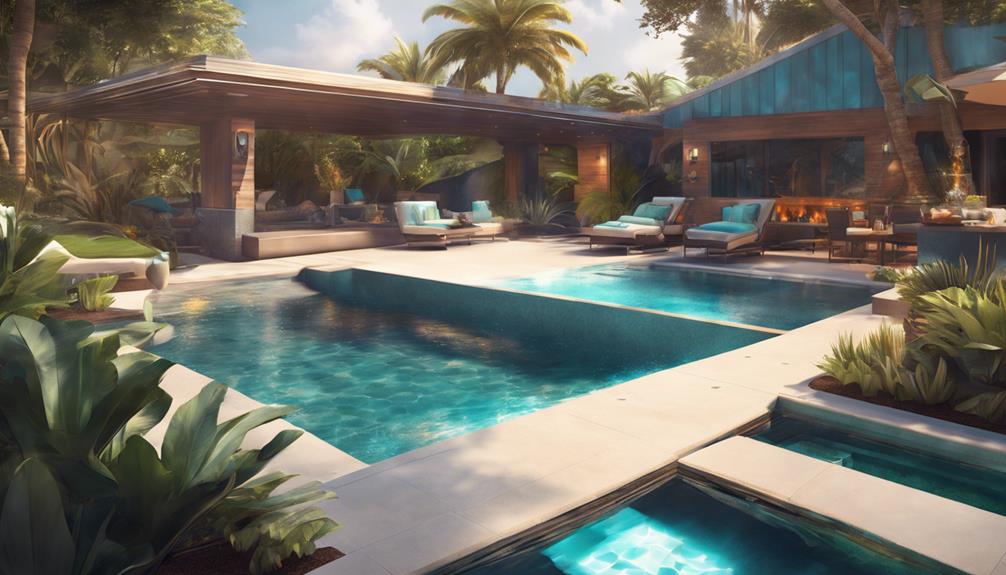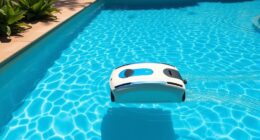Have you ever noticed the cool and blue appearance of swimming pool water? It’s like this: sunlight interacts with the water, causing it to absorb red light and reflect blue light, creating that inviting blue shade. Additionally, the depth of the pool impacts its blueness – deeper pools appear bluer because they absorb more light. Builders often choose blue materials, such as tiles, to enhance the blueness of the water! And there’s more to this story, so stay tuned to learn about how the sky’s reflection and pool maintenance help maintain that beautiful blue hue just right.
Key Takeaways
- Sunlight interacts, absorbs red light, reflects blue, creating color.
- Blue sky reflection influences water color, creating mesmerizing blue hue.
- Blue construction materials intensify water color intentionally.
- Water depth affects blue intensity; deeper pools appear bluer.
- Chlorine effectively combats algae, maintaining invigorating blue color.
Factors Contributing to Blue Pool Water
The blue color of swimming pool water is primarily influenced by various factors such as sunlight interaction and pool depth. When sunlight hits the water, it causes the water to absorb red light and reflect blue light, giving that cool blue hue to the pool water.
Deeper pools tend to look even bluer because they absorb more light, making the blue color more intense and vibrant. Also, if your pool has blue tiles or is made of fiberglass, these materials can enhance the blue appearance of the water, making it look even more inviting for a revitalizing swim.
Role of Blue Sky Reflection

Ever noticed how the color of the sky can make your pool water look even bluer?
It's not magic; it's all about how the sky's blue hue reflects in the water.
This reflection creates that invigorating blue vibe in your pool that you love so much!
Sky's Influence on Color
When gazing at a swimming pool, consider how the blue sky's reflection impacts the water's color. Have you ever noticed that on a clear day, the pool water seems to mirror the sky's blue hue? It's all about the sky's color playing tricks on your eyes.
The sky is blue, and that blue is reflected on the water's surface, making the pool look blue at the bottom.
So, next time you're floating around in the pool, take a moment to look up and appreciate how the sky's influence creates that mesmerizing blue color. The connection between the sky's blue and the water's reflection is like nature's own art project, resulting in the beautiful blue appearance of swimming pools.
It's fascinating to think about how a simple reflection can transform the water into a shimmering blue oasis. The next time you take a dip, remember to thank the blue sky for lending its color to make your swimming experience even more enchanting.
Optical Illusion Explanation
Ever wondered how the blue sky's reflection creates the optical illusion of swimming pool water appearing blue? Well, let's plunge into the science behind this fascinating phenomenon!
- Water molecules in the pool absorb red light and reflect blue light, enhancing the blue effect you see.
- The reflection of the blue sky on the water's surface plays a vital role in making the pool water appear blue.
- Adding blue tiles or fiberglass to pools intensifies the blue color by enhancing the reflection of the sky.
When sunlight interacts with the water molecules and the sky's reflection, a magical dance of colors happens right before your eyes, turning the pool water into a beautiful shade of blue.
It's like nature's very own paintbrush at work, creating this stunning optical illusion for you to enjoy every time you take a dip. So next time you're swimming, remember to thank the sky and those little water molecules for making the water look so invitingly blue!
Reflection and Perception
The reflection of the blue sky onto the water's surface greatly influences the perception of swimming pool water as blue.
When sunlight hits the water, it interacts with the water molecules and bounces off, carrying the blue color of the sky with it. This reflection creates that familiar and inviting blue hue that we associate with swimming pools.
If your pool has blue tiles or fiberglass, they can enhance this effect by intensifying the reflection of the blue sky, making the water appear even bluer.
Influence of Pool Construction Material

Pool construction materials, such as blue tiles or fiberglass, play a significant role in determining the blue hue of the water in swimming pools. When it comes to making your pool water that perfect shade of blue, the materials used in building the pool really matter. Here's how they influence the color:
- Enhanced Appearance: Blue tiles or fiberglass aren't just chosen for their durability; they also make the water look more vibrant and inviting.
- Deliberate Choice: Builders pick blue construction materials on purpose to give the water that beautiful blue hue that everyone loves.
- Maintaining Expectations: Using blue tiles or fiberglass ensures that your pool water stays blue and doesn't turn an unexpected color.
Red Wavelength Absorption

Absorbing red wavelengths of light, water molecules reflect blue light, giving swimming pool water its characteristic hue. When sunlight hits the water in pools, the water molecules absorb the red light and reflect the blue light back to our eyes. It's like the water is wearing blue-tinted sunglasses! This absorption and reflection process is what makes pool water look so inviting and invigorating. Check out the table below to see how this magic happens:
| Light Source | Water Absorption | Reflection |
|---|---|---|
| Sunlight | Red wavelengths | Blue light |
| Artificial | UV and infrared light | Blue and green |
| Moonlight | No significant absorption | Appears blue |
| Indoor lights | Varies depending on type | Could appear blue |
| LED lights | Controlled for color | Can be any color |
Impact of Water Depth

As you explore further into the pool, notice how the water's blue hue intensifies with each descent. Have you ever wondered why that happens? Well, it's all about the water depth! Deeper pools tend to appear bluer because water molecules absorb more light as you go down.
This increased light absorption enhances the blue effect you see in swimming pools. So, the deeper the pool, the more intense the blue color becomes.
- Water depth influences the intensity of the blue color in swimming pools.
- Light absorption by water molecules increases with greater depth, enhancing the blue effect.
- The larger the volume of water, the more pronounced the blue color appears.
Understanding how water depth impacts light absorption can help you grasp why swimming pool water looks so beautifully blue the further you explore. It's like a magical gradient of color waiting for you to immerse yourself in!
Importance of Maintenance Practices

Regular maintenance practices play an essential role in preserving the vibrant blue color of swimming pool water. To keep that inviting shade of blue, you need to stay on top of pool maintenance. Skim off leaves and debris, vacuum regularly, and test those pool chemicals.
Balancing the chemicals, especially chlorine, is vital to prevent algae growth and maintain the water's clarity and beautiful blue hue. Don't forget about those pool filters – keeping them clean guarantees all the gunk and yuck is removed, helping the water sparkle in that lovely shade of blue.
Testing the pH levels and adjusting as needed is important to keep the water looking clear and inviting. And remember, quick actions like shock treatments for algae or cleaning up after heavy rain can make a big difference in preserving the charm of your pool's blue waters.
Chlorine Shock Treatments for Algae

So, let's talk algae in your pool – not a pretty sight, right?
Chlorine shock treatments are like the superheroes swooping in to save the day, fighting off that green invasion like champs!
Picture this: your pool turning from a murky swamp into a crystal-clear oasis after a good shock treatment.
That's the power of chlorine, folks – keeping your pool water as blue as the sky on a sunny day!
Algae Growth Prevention
For effective algae growth prevention in your swimming pool, consider utilizing chlorine shock treatments to maintain the clear blue color of the water. Proper maintenance is key to keeping your pool water pristine and inviting.
Here are some tips to help you tackle algae growth:
- Regular Shock Treatments: Schedule routine shock treatments to combat algae and restore the blue hue of your pool water.
- Maintain Adequate Chlorine Levels: Make sure your pool has sufficient chlorine levels to inhibit algae development and keep the water looking fresh.
- Effective Filtration: Invest in a quality filtration system to help trap debris and prevent algae from thriving in your pool.
Chlorine Effectiveness Against Algae
To effectively combat algae growth in your swimming pool, consider the powerful impact of chlorine shock treatments in maintaining the invigorating blue color of the water. Algae presence can quickly turn your pool water from an invigorating blue hue to a murky green mess.
That's where chlorine steps in like a superhero, ready to save the day! Chlorine shock treatments are like a powerful weapon against algae invaders, swiftly eliminating them and restoring your pool's beautiful blue color.
Chlorine's effectiveness in fighting algae is unmatched. By keeping proper chlorine levels and using shock treatments when needed, you can prevent algae from taking over and keep your pool water crystal clear and inviting.
So, next time you notice any hint of green in your pool, don't panic! Just grab some chlorine shock treatment, follow the instructions, and watch as your pool transforms back into a stunning shade of blue.
Regular maintenance with chlorine shock treatments is the key to enjoying a sparkling blue pool all season long!
Shock Treatment Benefits
Harness the powerful impact of chlorine shock treatments to combat algae growth and maintain the invigorating blue color of your swimming pool water. When green pools start creeping in due to algae presence, a well-timed shock treatment can work wonders.
Here's why shock treatments are your pool's best friend:
- Say Goodbye to Green: Chlorine shock treatments are like magic wands that make green pools disappear, leaving behind crystal-clear blue water.
- Algae Annihilation: These treatments target algae directly, restoring your pool's natural blue hue by eliminating the pesky algae that cause discoloration.
- Chlorine Surge: By rapidly increasing chlorine levels, shock treatments effectively kill off algae and harmful bacteria, giving your pool a fresh start.
Frequently Asked Questions
Why Is My Pool Water Blue and Not Clear?
Your pool water's cool blue hue is like a science party happening underwater! It's all about red light getting absorbed and blue light doing a fab bounce-off by water molecules.
The deeper your pool, the deeper the blue – how neat is that? Even the pool's tile finish plays a role in this watery color magic.
Keep up with the chemical balance and regular maintenance, and your pool will stay crystal clear and blue-tiful!
Does Chlorine Make Water Blue?
Nope, chlorine doesn't make water blue. It's actually the way water molecules play with light that gives pool water its cool blue hue.
Chlorine's job is to keep the water clean, not to color it. So, next time you're swimming, remember, it's all about science and light making that water look so invitingly blue!
Keep splashing and enjoying your crystal-clear, blue pool!
Why Does a Swimming Pool Appear as Blue?
Ever wonder why a swimming pool dazzles in blue? Water molecules play a sneaky trick, gobbling up red light and flinging back blue hues for you to admire.
The deeper the pool, the darker the blue, as light gets swallowed up by the water. Blue tiles or fiberglass add a splash of extra charm.
With red light MIA, the pool's reflection is all about that cool, invigorating blue vibe.
Why Is Swimming Pool Water Blue During the Day?
During the day, swimming pool water looks blue because it plays a cool color game with light. The water munches on red light and throws back some blue light at you, making everything seem like a stylish pool party.
The deeper the pool, the darker the blue, as it slurps up more light. Even indoors, under those artificial lights, the water still rocks that cool blue vibe, making your swim extra chill.
What Causes the Blue Color in Swimming Pool Water?
The science of pool color involves the reflection of light by water molecules. In a swimming pool, the blue color is caused by the absorption and scattering of light. The water absorbs red, orange, and yellow wavelengths, while blue is reflected back, giving the pool its characteristic color.
What Causes the Blue Color of Swimming Pool Water?
The blue color of swimming pool water is due to a combination of factors, including the reflection of the sky and the pool’s depth. When sunlight hits the pool, the water absorbs red and yellow light, leaving primarily the blue light to be reflected. This process is why swimming pools are blue.
What Causes the Blue Color in Swimming Pool Water?
The main reasons swimming pools are blue is due to the reflection and absorption of light. The pool’s white surface reflects the blue sky, creating the illusion of a blue pool. In addition, the pool’s surface absorbs red and yellow light, leaving the blue light to dominate and giving the water its blue color.
Conclusion
So, next time you plunge into a sparkling blue pool, remember that it's not just magic – it's science! From the reflection of the sky to the depth of the water, there are many factors at play.
And don't forget, regular maintenance is key to keeping that beautiful blue hue. As they say, 'clear blue water, happy swimmers!'
Just keep swimming, and keep enjoying the cool, invigorating blue paradise of your pool.










